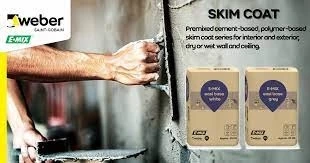When it comes to renovating or redecorating your home, one of the most essential aspects to consider is the surface of your walls. Plaster skim coats are one of the most popular options for creating a smooth and flawless wall surface. Let’s look at the basics of plaster skim coats and how they work.
What are Plaster Skim Coats?
Plaster skim coats are a type of plastering applied to a surface to create a smooth and even finish. They are typically thin layers of plaster, usually no more than 3mm in thickness. They are commonly used to repair or refurbish walls and ceilings that have surface damage, such as cracks or unevenness.
There are two types of plaster skim coats: gypsum plaster and cement-based plaster. Gypsum plaster is a mixture of gypsum, water, and sand, while cement-based plaster is a mixture of cement, water, and sand. Both types of plaster are easy to work with and provide a smooth finish.
How do Plaster Skim Coats Work?
The process of applying skim coats involves preparing the surface, mixing the plaster, and applying it to the surface. Once applied, the plaster is smoothed out and allowed to dry. The result is a smooth and even surface that can be painted or wallpapered. There are several benefits to using plaster skim coats. They are easy to apply, provide a smooth finish, and can be used on various surfaces. Additionally, plaster skim coats are durable and can last for several years if properly maintained. However, it is essential to note that plaster skim coats are not suitable for surfaces that are damp or prone to moisture.
Factors to Consider before Applying Skim Coats
Before applying skim coats, it is important to consider several factors. Firstly, the surface should be prepared and cleaned thoroughly to ensure that the plaster adheres correctly. Secondly, the time of application is crucial, and it is best to apply the plaster when the temperature and humidity are within the recommended range. Thirdly, the weather conditions should be taken into account, and it is recommended to avoid applying plaster when the surface is exposed to direct sunlight or high winds. Finally, it is essential to use the proper tools and equipment when applying skim coats.
Step-by-Step Guide to Applying Skim Coats
Surface preparation: Before applying skim coats, the surface should be clean and dry. Remove any loose or flaky paint, and sand down any rough spots. Use a primer or sealer to prepare the surface for the plaster.Mixing plaster: Follow the manufacturer's instructions to mix the plaster. Pour the plaster mix into a clean bucket and add water slowly, mixing thoroughly until you have a smooth and creamy consistency. Be careful not to add too much water, as this can affect the quality of the plaster.Application of plaster: Apply the plaster to the surface using a trowel or a plastering tool. Start at the top of the surface and work your way down, applying the plaster in thin layers. Use a smooth, sweeping motion to spread the plaster evenly across the surface.Smoothing out plaster: Once you have applied the plaster, use a plastering tool or a steel trowel to smooth out the surface. Work in a circular motion, moving from the top to the bottom of the surface. Be careful not to apply too much pressure, as this can cause the plaster to slide or become uneven.Allowing plaster to dry: Allow the plaster to dry completely before sanding or smoothing the surface. The drying time may vary depending on the thickness of the plaster and the temperature and humidity of the room.Sanding and smoothing: Once the plaster is dry, use a fine-grit sandpaper to smooth out any bumps or rough spots on the surface. Use a circular motion to sand the surface lightly, taking care not to sand too deeply. Wipe away any dust or debris with a clean cloth.Repeat the process: If necessary, repeat the process of applying and smoothing the plaster until you achieve the desired finish.Common Problems and Solutions in Skim Coats
While skim coats are relatively easy to apply, there are several common problems that may arise, such as bubbles, cracks, unevenness, and discolouration. These problems can be addressed by using proper techniques and tools, such as sanding or filling. It is important to note that if the problems persist, professional help may be required.
Find the Best Plaster Skim Coats
Saint Gobain Weber is a reputable company that offers high-quality plaster skim coats for various applications in construction and home renovation projects. With years of experience and expertise in the industry, the company has built a strong reputation for providing durable and reliable products that meet the needs of its customers. The company's commitment to innovation and continuous improvement has enabled them to stay ahead of the competition and offer cutting-edge solutions that deliver superior results. Whether you are a professional contractor or a DIY enthusiast, Saint Gobain's plaster skim coats are an excellent choice for achieving smooth, flawless finishes on walls and ceilings.


